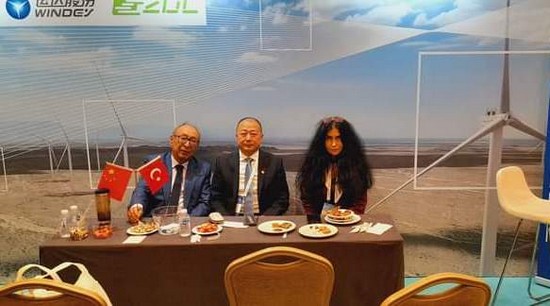Kategori : ENERGY AGENDA NEWS, WIND ENERGY & RES NEWS - Tarih : 11 November 2024
This year, the 13th Turkish Wind Energy Congress TUREK 2024 organized by TÜREK-Turkish Wind Energy Association provided an excellent opportunity to discuss the latest technological developments, innovative strategies and future projections. The congress, which was held on 5-6 November 2024, was hosted by Istanbul Hilton Bomonti Hotel.

Çiğdem Yorgancıoğlu, an expert in Information Technology, Telecommunication and Energy Contracts, a judicial expert and senior editor-in-chief of Enerji Gazetesi -Energy Magazine / Newspaper, who participated in the sessions led by leading experts and opinion leaders of the sector and also made a Chi Ci talks short programs at the Congress/ Fair, made the following statements in her various statements to World Türk TV and energy journalism.
Entrepreneurs, developers, sector and government stakeholders, academicians and even professionals, academics, the business world are actually all in the sector. Wind, like other renewable energy sectors, is a very comprehensive and multi-disciplinary approach. There are also regulations involved. Legislation is an important issue and if necessary, it needs to be renewed in accordance with the developments of the age. The energy sector means infrastructure, facility, human, work and environmental safety, which is also an important element. The system plan project coordination is important. Once the system is in place, solving the energy storage part is another issue. Wind is not only renewable energy, it is a critical infrastructure investment. It requires a management operation need that requires remote monitoring and rapid intervention with smart cameras positioned at the right angles. As a result, the sector’s difficulties and opportunities and advantages are discussed, but awareness also needs to be increased. It is extremely important to scale and accelerate wind project development and deployment safely, and my predictions are that a CRM (Crew Resource Management) approach based on the Chi Lange Challenge CLC 360 can improve the sustainability, security and resilience of the sector. We are increasingly hearing news about projects that aim to stimulate investment in renewable energy. New generation technologies that take measures to prevent service and efficiency loss during maintenance will also be more developed. It is necessary to look at it with a holistic approach on a global scale, along with local and regional fine-tuned studies. Governments in many countries are taking the necessary steps to minimize carbon emissions. They are forcing governments to spend money on renewable energy sources such as wind and solar. In other words, it will not work if they do not put their hands in their pockets. This is a matter of financing. The Offshore Wind Market data, referred to as “Offshore Wind Location” in English, is categorized as shallow water, transitional water and deep water according to location. When we look at energy initiatives specifically, the shallow water sector dominates the market. Why does it dominate the market? Because the installation of a Shallow water tower (i.e. Shallow water tower) is both easier and less costly to complete. Which one is more efficient and more secure is a separate issue of course. That’s why we have the CLC 360 ENERGY – WIND program. That’s why we have it to examine 360 degrees. There has been a huge increase in the amount of electricity generated by wind energy in recent years. , Europe, especially the countries bordering the North Sea, dominates the offshore wind industry. India’s Union Ministry of New and Renewable Energy (MNRE) wants to install 5 GW and 30 GW offshore capacity by 2022 and 2030. Competition and market expansion will increase further with R&D investments. The World Economic Forum predicts that the offshore wind market will be worth $1 trillion by 2040. Africa, for example, is a completely different phenomenon in the field of renewable energy. A geography where the sun’s rays are perpendicular to the earth’s surface . The solar energy sector will grow as well as the wind. We also see hybrid projects. In one of its studies, the World Bank Group’s private sector arm IFC points out that continental Africa has an onshore wind potential of approximately 180,000 Terawatt hours (TWh) per year. This means that it is enough to meet the electricity demand of the entire continent by 250 times. In other words, a tremendous potential. We should also remember that it is not possible for hundreds of millions of people living in Sub-Saharan Africa to have access to electricity. The sector will grow, but the important thing is that the sharing is fair, sustainable, for the benefit of humanity and development. At the beginning of the new millennium, many wind farms were established in Africa. For example, one year after the establishment of these farms, I was in South Africa on one of the important legs of my World Tour project. Similarly, in Kenya, after I celebrated my birthday on a safari in Masai Mara, wind farms were established in the country a year later. Egypt and Morocco are all geographies I have visited. There are very rapid developments in solar and wind in Africa, which will accelerate even more. I was invited to an energy congress in Africa, I will not be able to attend for various reasons, but I am following the importance of the subject . There was an energy conference on Africa in Istanbul last month and an Africa summit in Istanbul this month. I am talking about AFEX. I had shared my impressions of the participation in the Energy newspaper -Enerji Gazetesi in English. We are also talking a lot about Africa. I mean the renewable potential of Africa. In the meantime, we are talking about wind farms in Africa, but on the other hand, our eyes and ears will be on where the farmers’ votes will be directed in Nevada or Arizona, the flagship states of the USA. Today is a big day for the USA. We are focused on the 2024 presidential elections. World energy authorities are talking about the differences in the approaches of the two leaders. As is known, Trump withdrew from the Paris Climate Agreement. Of course, it seems like we will talk more about Trump no matter who wins. As a risk expert, we need to pay attention to everything from tribune maintenance to non-damaging maintenance to environmental impacts. Likewise, it is a subject that touches on many areas specific to the maritime and aviation fields that I work on. In other words, it should be addressed in a multi-layered manner. Protective and preventive maintenance is also important. Also, monitoring and supplying critical stock materials is another issue. Acting according to the requirements of quality standards is another dimension. An ethical perspective that adopts both cognitive and transparent management processes to reduce externality costs is required. The subject we emphasize is CLC 360 ENERGY -WIND.
In short, it is an area that does not allow for a gap in risk,safety and security that requires a very disciplined,intra-disciplined approach. It should be meticulously approached, integration with future technologies is important, steps should be taken without forgetting that the slightest sensor failure or deviation in calibration can lead to very large damages, accidents and problems. The global wind industry broke a record in 2023 by taking the wind behind it and established 117 GW of new capacity according to reports. In other words, the best of all time in wind. There are many reports like this year’s Global Wind Report of the Global Wind Energy Council. Sources and findings say that the wind industry has entered a new period of accelerated growth driven by increasing political ambition, which manifested itself in the historic COP 28 acceptance of the goal of tripling renewable energy by 2030. Wind is growing. The role of wind energy in Turkey’s energy portfolio will grow in a similar way, the number of wind power plants and their efficiency will also increase, sector stakeholders say that technology is developing very fast, new technology is being used until we get feedback, let’s see what new generation technologies will bring in order to increase financing resources and reduce costs. Another expectation expressed is that changes should be made in the legislation to ensure the progress of the sector. There are many issues that need to be examined. The congress and fair are well prepared and productive, and it is an extremely positive approach that they added logistics engineering and occupational safety areas to the participants and speeches. We also hear many observations and predictions about the difficulties in the sector, there were areas that I cared about in terms of research, I took notes of all of them. I thank those who contributed. I wish success to all speakers and participants who I will not be able to attend on the second day.
Çiğdem Yorgancıoğlu also spoke to various press organizations, World Türk TV and “Energy Magazine -Energy Gazette -Enerji Gazetesi “about the sector in general.
Nowadays, not only physics-based modeling but also Artificial Intelligence is emerging in prediction systems. Information technologies will realize green transformation and digital transformation together.
The electricity produced by wind farms is variable. The production of a wind park depends on the condition of the turbines, the complexity of the site, as well as wind conditions such as wind direction and wind speed at the height of the turbines ; their predictions are also important at this point. In order to optimize the integration of renewable energy into electricity markets and networks, players in the energy sector should estimate the production of wind turbines. Therefore, it should not be ignored. Rare -earth elements can be used in turbines, this should also be kept in mind because it is of strategic importance. These elements are needed for magnets, and Turkey is making progress in this regard.
Wind energy is a renewable energy source that has gained popularity in recent years, especially in the aviation and maritime sectors. The MIM CHI 360 -CLC360 ENERGY – WIND program is our training program on the benefits of using wind energy in these industries and how we can contribute ethically and safely to reducing carbon emissions and creating a more sustainable future.
Unlike fossil fuels, which release harmful greenhouse gases into the atmosphere when burned, wind energy does not produce carbon emissions. This makes it an environmentally friendly alternative to traditional fuels and helps reduce the impact of these industries on the environment. In the aviation industry, wind energy can be used to power small aircraft and drones. By using wind energy, airlines can reduce their carbon footprint and help combat climate change. There are challenges, of course. When modern wind turbines reach heights of up to 250 m above the ground, they can pose a physical obstacle to low-flying aircraft, posing a hazard. Often, the biggest problems are near small general aviation airports. However, larger airports, low-flying zones and corridors, and helipads should also be considered. More space and areas need to be considered for Obstacle Limitation Surfaces (OLS) and flight procedure protection around airports. In addition, the spinning blades of wind turbines create downwind turbulence. Such turbulence can be dangerous, especially for small and light aircraft. Although more research is needed on safe distances to wind turbines, some guidance is available and should be taken into consideration. Namely, the wind turbine-induced turbulences that I mentioned. If a solution is found and the risks are taken into account, the problems will be solved. Where you position the wind turbine is also very important, otherwise you may even have to relocate it, which means costs. Of course, the damage you will cause due to incorrect installation or wind turbine positioning is a separate issue. For example, recently airsight has conducted numerous studies on wind farms and aviation safety, strengthening its leadership position in this field. The projects addressed typical problems and flight procedures of proposed wind turbines creating physical obstacles near airports. They even published this on their official website. In addition, wind turbine-induced turbulences were also taken into account for these situations. In addition, regarding obstacle lighting, airsight conducted several studies addressing the fact that the proposed lighting of wind turbines does not comply with national specific regulations. In cases where CNS facilities would be affected by wind turbines, airsight conducted feasibility studies including the arrangement for the removal, relocation and replacement of such facilities. In short, as they say, a bad calculation can make a comeback. In the maritime sector, wind energy can be used to power ships and boats. By installing wind turbines on ships, they can harness the power of the wind and use it to generate electricity. This can help reduce reliance on fossil fuels and reduce operating costs for shipping companies. In addition, the use of wind energy can help ships become more sustainable and environmentally friendly, contributing to a cleaner and healthier ocean. Overall, wind energy has the potential to revolutionize the aviation and maritime industries by providing a clean and renewable energy source.
H. Çiğdem Yorgancıoğlu – Energy Contracts Expert / Forensic Person / ‘Enerji Gazetesi’ Senior Author – http://www.cigdemyorgancioglu.org/






